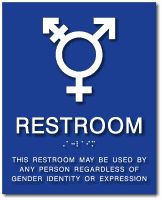OSHA – On June 1st, at the request of the National Center for Transgender Equality, the Occupational Safety and Health Administration published a Best Practices: Guide to Restroom Access for Transgender Workers.
“The core principle is that all employees, including transgender employees, should have access to restrooms that correspond to their gender identity,” said Assistant Secretary of Labor for Occupational Safety and Health Dr. David Michaels. “OSHA’s goal is to assure that employers provide a safe and healthful working environment for all employees.”
The basis for these new recommendations come from OSHA’s Sanitation Standard (1910.141), which requires employers to provide their employees with sanitary and easily accessible toilet facilities. The main intent of this standard is to protect employees from the potentially dangerous health effects that result from the lack of available toilets. This standard includes provisions ensuring that employers do not impose restrictions on the use of toilet facilities.
To comply to these new guidelines, it is important to implement policies that guarantee access to sanitary restrooms for all employees, regardless of gender identity.
“For example, a person who identifies as a man should be permitted to use men’s restrooms, and a person who identifies as a woman should be permitted to use women’s restrooms”.
While creating an additional gender neutral space or gender neutral restroom may seem like a simple and easy way to comply to these new guidelines, OSHA urges avoiding this solution. The goal is to create an inclusive and safe space for all employees, guaranteeing that all employees have equal access to necessary facilities and amenities. By creating a gender neutral restroom, the company singles out those individuals, segregating them from the rest of the workers, which may cause social insecurity and distress. This form of bathroom restriction can result in avoidance of the restroom and potentially lead to physical injury or illness. Transgender individuals must be free to utilize the restroom that is consistent with their gender identity to avoid segregation and isolation.
“Under these best practices, employees are not asked to provide any medical or legal documentation of their gender identity in order to have access to gender-appropriate facilities. In addition, no employee should be required to use a segregated facility apart from other employees because of their gender identity or transgender status. Under OSHA standards, employees generally may not be limited to using facilities that are an unreasonable distance or travel time from the employees worksite”
It is important to remember that these are recommendations and guidelines, and creates no new legally binding obligations. They are advisory in nature and intend on providing a safe and healthy workplace for all employees. Furthermore, awareness of other Federal, State and local laws regarding restroom access in addition to anti-discrimination laws is essential for every employer in regards to compliance.
For more information, please visit the official OSHA Trade News Release (here), or go directly to their Guide (here). And as always, feel free to contact us at The Integrated Group with any questions or concerns at 425.822.8500







No comments yet.